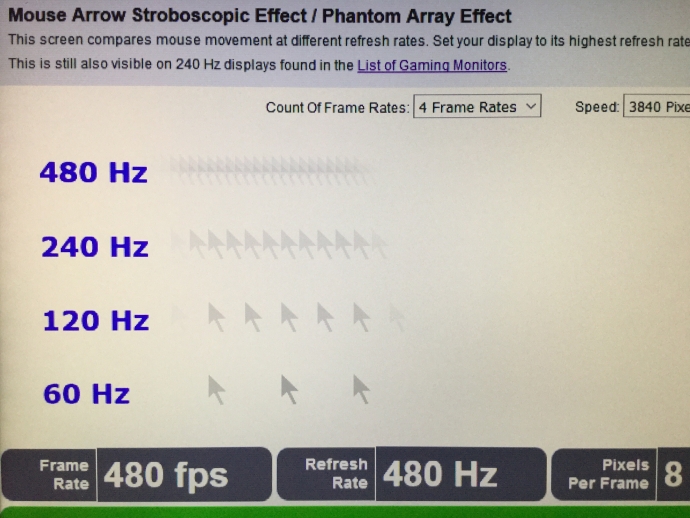Ever since the Blur Busters Holiday Special article about the Amazing Journey to 1000Hz Displays and the earlier true 480Hz monitor tests, Blur Busters has been paying much more attention to HFR video developments.
We are the only website in the world to exclusively talk about “Better Than 60Hz”. This universe also includes 120fps HFR. However, there are also experiments with Ultra HFR — the art of displaying video at ultra high frame rates (HFR 240fps, 480fps and 1000fps) in real-time on ultra high refresh rate displays. Not slow motion!
Longtime readers are familiar with our world’s first embedded 120fps HFR web browser videos and world’s first 120fps gameplay video five years ago (Year 2013)
Now, we are testing video beyond 120 frames per second!
Ultra HFR: True 240 fps Real Time
Here is a method of creating 240 frame per second HFR video, for play back on today’s 240 Hz eSports monitor.
- Get any favourite slo-mo camera capable of 240fps.
…From smartphones to GoPros to Phantom Flex cameras, many cameras now can do 240fps. - Get a GPU capable of 4K60 playback.
…GPUs capable of 4K 60fps playback are also able to do 1080p 240fps playback. - Get a true-240Hz gaming monitor. See List of Best Gaming Monitors.
- Download and install ffmpeg.
- Record video in normal 240fps slo-mo. Resulting file is 30fps.
- If you need to use a video editor, edit while video is still slo-mo. Then export an .MP4 video.
- Finally, run this ffmpeg command line to speed up the video back to real-time playback.
This speeds up video to play at 8 times the frame rate, converting 30fps to 240fps.ffmpeg -i slowmo240.mp4 -r 240 -vf "setpts=(1/8)*PTS" -an realtime240.mp4 - Play the video in your player (VLC, MPC-HC, Windows Media, etc) on your 240 Hz display.
…You may need to experiment with different video players to find the best 240fps experience.
High speed cameras, designed for slo-mo, often do not record audio well. At the moment, the best way to add audio is to record the audio separately, and use a command line utility to dub the audio onto the sped-up file.
The same general instructions apply to 480fps and 1000fps HFR, with different speedup factors (replace number “8” with the appropriate speedup factor).
Share your results in the new Blur Busters Forums High Frame Rate (HFR) Video discussion area!
Future 1000fps HFR: 240fps is not the final frontier
In the newly created Blur Busters HFR Forum, there is a thread worth reading about Ultra HFR.
The art of playing true 1000fps real time on true 1000Hz displays: Cinematography of 2030s: Ultra HFR (1000fps at 1000Hz!)
Experimental 1000 Hz displays are already available, and will eventually be cheap within one human generation. Now even some smartphones are also gaining ultra-high frame rate video recording capabilities too. This presents opportunities for cheap Ultra HFR in the coming years!

By doing 1000fps HFR on a 1000Hz display, you can simultaneously avoid camera motion blur and avoid display motion blur and avoid stroboscopic effects. Strobless low-persistence (blurless sample-and-hold) without flicker is successfully achieved with 1000 Hz experimental laboratory displays, and is also useful with Ultra HFR video.
Time-wise, the difference between 120fps HFR versus 1000fps HFR is roughly as big as the difference between 60fps and 120fps. This is because 1/60sec and 1/120sec is an 8.3ms difference, while the difference between 1/120sec and 1/1000sec is a 7.3ms difference. There is a curve of diminishing points of returns, but the massive jump up to 1000fps HFR greatly compensates.
At Blur Busters, we are among the few people in the world to have witnessed Ultra HFR video!
We believe this is very useful for many applications in the coming decade, from speciality theatre, virtual reality, amusement park rides, advanced cinema, truly immersive virtual vacations, “Holodeck” video, and other applications once more 1000 Hz displays are commercially available beginning sometime within the next decade and beyond.